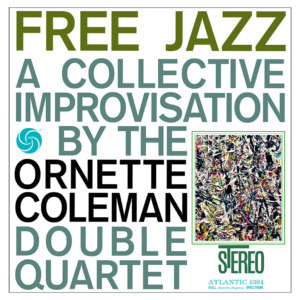Ornette Coleman – Free Jazz
Speakers Corner/Atlantic (Original Recording 1960)
180g LP Atlantic 1364
By Dennis Davis

During his 85 years on this planet (1930 – 2015), Ornette Coleman recorded almost 60 albums as band-leader and appeared as a sideman on another dozen. He occasionally stepped back from public concerts, but in the mid-1990s began a ten-year period of regular public performances, of which I was fortunate to catch six. Coleman’s acceptance by the jazz audience came slowly.
At first, some of the earlier generation of jazz greats dismissed him as an unschooled noisemaker. But before long, he was the darling of almost everyone, from John Coltrane to Jerry Garcia. Today, any jazz fan knows who Ornette is, without hearing his last name. His is among the elite names in jazz, like Miles, Trane and Duke.
His early recordings for Contemporary and Atlantic, as well as his handful of Blue Note recordings, have become highly collectable. Euros, British Pounds or US Dollars, a near mint copy of any of these titles is going to set you back somewhere in the three-digit range. The Contemporary and Atlantic titles were all available in mono pressings, and near mint mono originals are rare as hen’s teeth. Until recently, those mono versions were also undisputedly the best way to hear these titles. But Speakers Corner’s recent Ornette releases have challenged that status quo.
The most ambitious of these early titles, Free Jazz, became the name of an evolving approach to jazz improvisation. These days, Coleman’s other Atlantic titles—The Shape Of Jazz To Come, Change Of The Century and This Is Our Music sound tame by comparison. Recorded in a single take, Free Jazz was recorded by a double quartet of musicians and recorded on two tape machines—one for stereo and the other for mono. The stereo version presented Ornette with Donald Cherry, Scott LaFaro and Billy Higgins in the left channel, and Eric Dolphy, Freddie Hubbard, Charlie Haden, and Ed Blackwell in the right channel. The group consists of eight “stars” with no fillers. However, any jazz lover will recognize immediately that these players represent a spectrum of styles, with the most “conservative” players, LaFaro and Hubbard separated, one in the left and the other in the right channel. There was little preparation for the session other than Ornette’s provision of a few brief written parts from which the musicians were asked to improvise. Each player had a solo space of about 5 minutes except Ornette who got 10. Other than that, it was spontaneous group improvisation for 38 minutes. The result is widely considered a milestone in jazz recordings. Needless to say, thisis not background music. Nor is it music for everyone. This touchstone of modern jazz is best listened to with eyes firmly closed and no distractions other than the requirement to get out of you chair once – to flip the LP over to side two.
Free Jazz is Speaker Corners’ second foray into the Ornette Coleman catalog. Earlier last year, they released The Shape OfJazz ToCome, Coleman’s third album (released by Atlantic in 1959) and it sold out almost immediately. It now resides in the category of “awaiting repress” or “back ordered,” terms that, in these Covid days equate to, “don’t hold your breath.” Free Jazz, recorded in December 1960 and released late the next year, remains available, but will probably also soon join the ranks of the backordered so get it while you can.
- 1
- 2

